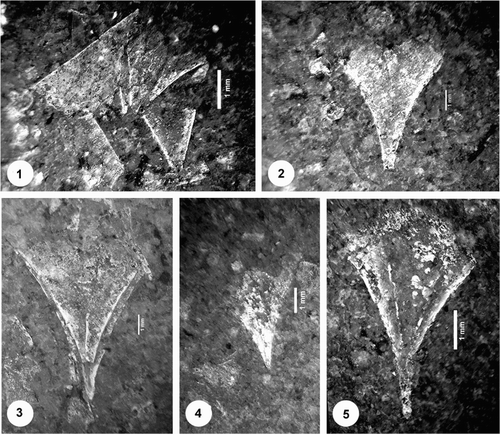ABSTRACT
Three pteropod species are recorded from late Waitakian–Otaian (Aquitanian–early Burdigalian) rocks of the Taumarunui Formation (Mahoenui Group) outcropping southwest of Taumarunui, King Country, New Zealand. Two of these, Limacinidae sp. and Clio sp. have been recorded in open nomenclature due to poor preservation. The third, Clio triplicata Audenino, Citation1899, was previously known only from Miocene deposits in Europe and offers possibilities for long-distance correlation.
Introduction
The pteropod fossils recorded here were found in Taumarunui Formation strata (, A–C) exposed in Herlihy Bluff (38.9171°S, 175.2316°E) on State Highway 43, c. 5 km southwest of Taumarunui, King Country, central North Island. The strata have a regular alternation of dm-bedded turbiditic sandstones and hemipelagic mudstones (Kamp et al. Citation2004). The undersides of the sandstone slabs have ripples, load casts or flute marks. Fossils are mostly occasional foraminifera and vegetal debris (leaf and wood fragments).
Figure 1. Location of Herlihy Bluff along the Whanganui River, southwest of Taumarunui, King Country, North Island, New Zealand. New Zealand Fossil Record Electronic Database, fossil record number S18/f0056. Basic map data from GoogleEarth.
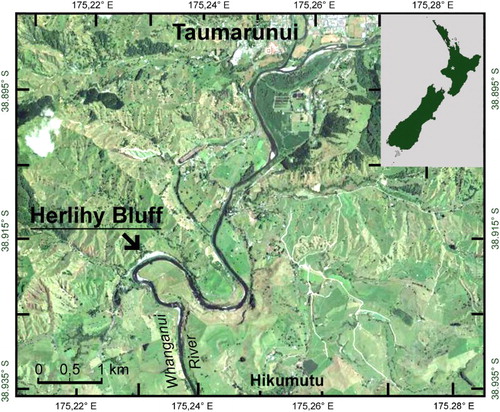
Figure 2. Herlihy Bluff outcrop of Taumarunui Formation on State Highway 43. A, Overview. B, Debris in the trench at the base of the section. C, Detail of Figure 2B (hammer head is 16.5 cm). Photographs: Lynette L. Hellyar. D, Concentration of poorly preserved Limacinidae sp. indet. on slab 2, Naturalis Biodiversity Center collection RGM 777 442a. E, Clio sp. indet. on slab 2. Naturalis Biodiversity Center collection RGM 777 442b. Photographs of Figure 2D and 2E: Ronald Pouwer.
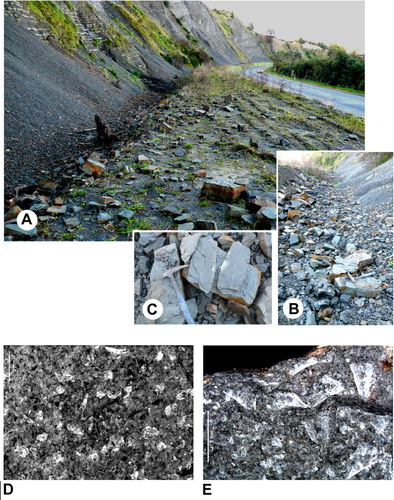
During a visit to Herlihy Bluff on 30 April 2016 with the Auckland Geology Club, the second author found two slabs of fallen rock containing a large number of triangular fossils. They appeared to be rather poorly preserved holoplanktic Mollusca (Pteropoda) resembling the recent species Clio pyramidata Linné, Citation1767. Because that species had never been found on land as a fossil in New Zealand, the two slabs were sent to the first author in the Netherlands for identification.
A number of fossil pteropods have been recorded previously from New Zealand (Beu & Maxwell Citation1990; Janssen Citation2006; Maxwell Citation2009). The following Miocene species are now known (original and present-day names):
Family Limacinidae Gray, Citation1840
Spiratella atypica Laws, Citation1944 = Heliconoides atypicus (Laws, Citation1944); genus assignment changed herein on the basis of Janssen (Citation2003)
Spiratella ferax Laws, Citation1944 = Heliconoides ferax (Laws, Citation1944); genus assignment changed herein on the basis of Janssen (Citation2003)
Family Cuvierinidae Van der Spoel, Citation1967
Vaginella torpedo P. Marshall, Citation1918 = Cuvierina torpedo (P. Marshall, Citation1918); genus assignment changed by Janssen (Citation2005, Citation2006)
Vaginella aucklandica Clarke, Citation1905 = Ireneia aucklandica (Clarke, Citation1905); genus assignment changed by Janssen (Citation2006)
Clio (Creseis) urenuiensis Suter, Citation1917 = Ireneia calandrelli (Michelotti, Citation1847); genus assignment changed by Janssen (Citation2005, Citation2006)
Ireneia nieulandei Janssen, Citation1995
Family Cavoliniidae Gray, Citation1850 (1815)
Vaginella inflata Hayward, Citation1981 = Vaginella depressa Daudin, Citation1800; synonymised by Janssen (Citation2006).
Family Sphaerocinidae Janssen & Maxwell in Janssen, Citation1995
Lornia marwicki Powell, Citation1935 = Sphaerocina formai (Audenino, Citation1899); genus assignment and synonymisation by Janssen and Maxwell, in Janssen (Citation1995)
In addition to these described species, there is unstudied fossil pteropod material, collected by the late Philip Maxwell and Andrew Grebneff, housed in the GNS Science collections at Lower Hutt. It is likely that additional species will be present in this material.
The study of the first two slabs from Herlihy Bluff resulted in the recognition of two pteropod species. Both were unfortunately too poorly preserved to identify with any degree of certainty. On a repeat visit to the bluff, the second author managed to collect two further slabs with better preserved pteropods, including a new record for the New Zealand Miocene.
Material and methods
Four slabs (numbered 1 to 4) from Herlihy Bluff were studied. Slab 1 is in the private collection of the second author. Slab 2 (A–B) is in the Naturalis Biodiversity Center, Leiden, The Netherlands (RGM 777 442). Slab 3 was cut into two pieces, one is in the National Paleontological Collection at GNS Science, Lower Hutt, New Zealand (GS15834, TM9252) and the other is in the Naturalis Biodiversity Center (RGM 777 443). Slab 4 is also housed in the GNS Science collection (GS15834, TM9253). The site is registered in the New Zealand Fossil Record Electronic Database, fossil record number S18/f0056 (http://www.fred.org.nz). All specimens were collected by the second author. Slab 4 is the only one with numerous specimens on both sides. Some unrecognisable bivalve fragments are present on the back of slab 2. All specimens are poorly preserved, with the original shell material partly dissolved. No further preparation or preservation was done.
Figure 3. Slab 2 with numerous specimens of Limacinidae indet. and Clio sp. indet.. A, Overview. The framed part in A is enlarged in Figure 3B; Naturalis Biodiversity Center collection (RGM 777 442). Photographs: Ronald Pouwer. B–D, Clio triplicata Audenino, Citation1899. B, Cast of ventral side, slab 4, GNS Science collection (GS15834, TM9253c). C, D, Casts of dorsal side, slab 3, GNS Science collection (GS15834, TM9252c) and Naturalis Biodiversity Center collection (RGM 777 443a), respectively. Photographs: Eduard F. de Vogel.
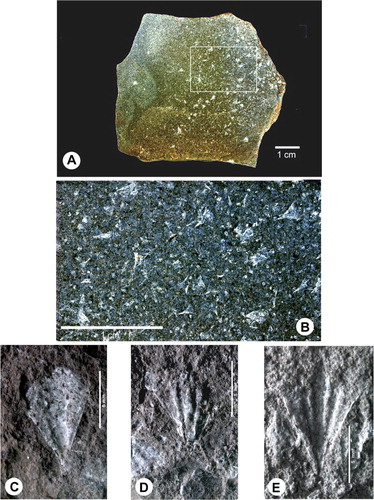
Age and paleoenvironment
The Taumarunui Formation is part of the Mahoenui Group (Glennie Citation1959) of late Waitakian (Lw)–Otaian (Po) age (Aquitanian–early Burdigalian, 23–18.7 Ma; Edbrooke Citation2005; Raine et al. Citation2015). One sample collected from Herlihy Bluff (S18/f15) by Topping (Citation1978) contained 90% planktic foraminifera, which include well-preserved specimens of Globoquadrina dehiscens (Chapman et al. Citation1934) (Lw–late Miocene), Globigerina woodi Jenkins, Citation1960 (middle Lw–Pliocene), Globigerina woodi connecta Jenkins, Citation1960 (late Lw–Po) and Catapsydrax dissimilis (Cushman & Bermúdez Citation1937) (Oligocene–Po) confirming a late Waitakian–Otaian age for the pteropod-bearing rocks. The small benthic foraminiferal fauna is most similar to early Miocene association G from the Waitemata Basin, 400 km to the north, which is inferred to have lived at bathyal depths with low carbon flux and oxic to suboxic bottom conditions (Hayward & Triggs Citation2016). The presence of specimens of Eggerella bradyi (Cushman Citation1911) and Scallopostoma ovicula (d’Orbigny Citation1826) with upper water depth limits of 750 and 900 m, respectively (Hayward & Triggs Citation2016) suggests probable lower bathyal depths (1000–2000 m). The 90% planktic foraminifera provide an estimate of 950 ± 100 m water depth based on a regression equation relating modern planktic per cent values around New Zealand to water depth (Hayward & Triggs Citation2016). All the above proxies for paleo-water depth for the Taumarunui Formation at Herlihy Bluff give depths in the order of 900–1500 m.
Systematics
Phylum Mollusca Linnaeus, Citation1758
Class Gastropoda Cuvier, Citation1795
Subclass Heterobranchia Burmeister, Citation1837
Order Thecosomata de Blainville, Citation1824
Suborder Euthecosomata Meisenheimer, Citation1905
Superfamily Limacinoidea Gray, Citation1847
Family Limacinidae Gray, Citation1847
Limacinidae indet.
D
Material examined: Hundreds of poorly preserved specimens on all four collected slabs; Hellyar, Naturalis Biodiversity Center (RGM 777 442–443) and GNS Science collections (GS15834, TM9252a–TM9253a).
Description: All specimens appear as very small white items. A few of them can be recognised as sinistrally coiled limacinids but do not show any further morphological details, apart from one or two specimens that possibly have a peripheral belt.
Discussion: It cannot be decided whether the specimens from Herlihy Bluff are conspecific with one or both limacinid species known from the New Zealand Miocene (see above). Both species belong to the genus Heliconoides, meaning that in the adult stage they possess well-developed reinforcement structures on their apertural margin. Despite the many specimens available, such structures could not be recognised. In one or two specimens, however, a peripheral belt as seen in the species Heliconoides inflatus (d’Orbigny Citation1834–1847; see Sherborn & Griffin, Citation1934 for publication dates) seems to be present, but without any degree of certainty. The species H. inflatus is one of the most commonly occurring pteropod species in the present-day tropical–subtropical oceans and it is known to be present from the late Oligocene onwards. Although it has not been recorded previously from the New Zealand Miocene, it is present in somewhat younger sediments of Balcombian to Bairnsdalian (=Langhian to Serravallian) age in southern Australia (Janssen Citation1990a). Its occurrence here seems quite acceptable but needs confirmation by well-preserved specimens.
Family Cliidae Jeffreys, Citation1869 (ICZN, Citation2006. Opinion 2133)
Genus Clio Linné, Citation1767
Clio triplicata Audenino, Citation1899
C–E
Type material: Lectotype in Museo Regionale di Scienze Naturali, Torino, Italy, registration number TTI 21.1.1 (internal mould and cast of ventral side), illustrated in Janssen (Citation1995, pl. 8, fig. 1; herein copied as ).
Figure 4. Clio triplicata Audenino, Citation1899; lectotype; Monte dei Cappuccini, Torino, Italy. Collection Museo Regionale di Scienze Naturali, Torino, Italy, registration number TTI 21.1.1, height of internal mould 14.6 mm. A, Dorsal view. B, Ventral view of mould. C, External cast of ventral side (after Janssen Citation1995, pl. 8, a–c).
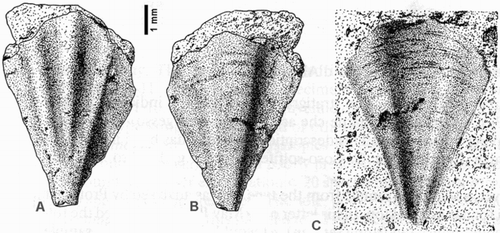
–
Type locality: Monte dei Cappuccini, Turin, Turin Hills, northern Italy (Complesso di Baldissero Formation; middle Miocene, Langhian).
Material examined: Three specimens: one cast of ventral shell part on slab 4 (C) in the GNS Science collection (GS15834, TM9253c); two casts of dorsal shell part on cut pieces of slab 3 (D–E), one in the GNS Science collection (GS15834, TM9252c), one in the Naturalis Biodiversity Center collection (RGM 777 443a), respectively.
Description: Shell triangular, with apical angle of c. 50°. Dorsal shell part moderately convex with three strong radial ribs, central one slightly wider than lateral ones. Ventral part with single flattened central rib, slightly wider than lateral zones. Lateral carinae and protoconch not preserved in the present specimens.
Discussion: Previously, Clio triplicata was exclusively known from European localities. It was recorded from early to middle Miocene (Aquitanian to Langhian) localities in Italy (Robba Citation1972; Janssen Citation1995, Citation2012), and also from some Paratethys localities (Zorn Citation1999). Therefore, its occurrence in the Miocene of New Zealand is surprising, although it is by no means the only example of such disjunct distribution. Several of the New Zealand Miocene pteropod species, as listed in the Introduction, were also originally described on the basis of European material (i.e. Ireneia calandrelli, I. nieulandei, Vaginella depressa, Sphaerocina formai). Similar examples are known from the South Australian Cenozoic pteropod assemblages (Janssen Citation1990a, Citation1990b). Another example from New Zealand is the early Pliocene Cavolinia grandis (Bellardi Citation1873), originally described from northern Italy, but recorded from the South Island, West Coast, McKay Creek, Kaniere Valley (Pliocene, Waipipian, Bluebottom Formation) in the unpublished MSc thesis of Almond (Citation1980, p. 231) as Cavolinia tridentata f. zelandica Almond, nomen nudum (further described and illustrated in Janssen Citation2000).
Clio sp. indet.
E, A–E
Material examined: Abundant specimens on all four available slabs; Hellyar, Naturalis Biodiversity Center (RGM 777 442–443) and GNS Science (GS15834, TM9252b–TM9253b) collections.
Description: All specimens are poorly preserved with partly dissolved shells that appear as small triangular white spots on the slab surfaces. In some of the larger specimens, the lateral carinae demonstrate a slightly concave shape, resembling the species Clio pyramidata Linné, Citation1767, which explains why initially the specimens were thought to represent that species. All specimens are completely flattened. Dorsal or ventral sides of the shell cannot be distinguished and protoconchs are not preserved. Even in a flattened state the shells should show the radial ribbing of C. pyrimidata, which is not the case. Specimens appear to have a completely smooth shell on both ventral and dorsal sides. Clio pyramidata is known exclusively from late Miocene onwards, which makes an occurrence in these early Miocene rocks improbable .
Discussion: We know of just a single comparably triangular Clio species without dorsal and ventral ribbing, which is the middle Miocene (Langhian) Clio saccoi Checchia-Rispoli, 1921, described from the Lago di Varano Formation of the Gargano Peninsula in central Italy. In that species, both ventral and dorsal shell parts are slightly convex with narrow concave zones along the carinae. The Taumarunui specimens do not show even a trace of that morphology and are not thought to belong to that species, which is only known from European localities. This leads to the (premature) conclusion that the Taumarunui specimens represent an undescribed Cliidae species but the material is far too incomplete to formally describe and name it.
Conclusions
Early Miocene (late Waitakian–Otaian; Aquitanian–early Burdigalian) sedimentary rocks of the Taumarunui Formation, Mahoenui Group, exposed c. 5 km southwest of Taumarunui, central North Island, New Zealand, yielded three species of Pteropoda (Gastropoda, Euthecosomata), the two most abundant of which are recorded in open nomenclature as Limacinidae sp. indet. and Clio sp. indet. A few other specimens are identified as Clio triplicata Audenino, Citation1899, a species originally described from northern Italy and previously known only from Europe.
It is suggested that the Limacinidae sp. might (probably in part) belong to Heliconoides inflatus (d’Orbigny Citation1834–1847; see Sherborn & Griffin, Citation1934 for publication dates), a widespread species with a stratigraphic range of late Oligocene to recent, also known from the Miocene of southern Australia. The Clio sp. cannot be related with any confidence to known cliid species and might be undescribed. Its state of preservation, however, prevents introduction of a new taxon.
Interesting from a paleoenvironmental point of view is the fact that at the studied locality pteropods were only found to be present on a very restricted number of sediment slabs, but when present occurred in large numbers of specimens. This indicates that pteropod populations only occasionally entered the basin, in spite of the fact that a bathyal paleodepth is accepted for the Taumarunui Formation. Such occasional occurrences can be explained by short-term changes in ocean currents, possibly under the influence of climatic conditions (e.g. storms).
The occurrence of Clio triplicata represents a further example of disjunct pteropod distribution that may have important implications for long-distance correlation. In the present-day pteropod biogeography, many species occupy large parts of the world’s oceans, usually according to climatic zones (such as subarctic, temperate, bisubtropical or tropical). Very remote occurrences of species therefore not only offer possibilities for chronostratigraphical correlations, but also indicate comparable paleoenvironmental conditions. Although at present the number of such long-distance correlations on the basis of pteropods is still restricted, they are potentially very useful in these respects and may basically be compared with other such pelagic organisms, like planktic foraminifera and calcareous nannoplankton.
Acknowledgements
The authors are grateful to Bruce Hayward (Geomarine Research, Auckland, New Zealand) for supplying the data on age and paleoenvironment, as well as for much appreciated linguistic help. Alan G. Beu (GNS Science, Lower Hutt, New Zealand) is thanked for his interest and critical reading of an earlier version of the manuscript. Ronald Pouwer, Eduard F. de Vogel (both Naturalis Biodiversity Center, Leiden, The Netherlands) and Tim Saunderson (Auckland, New Zealand) took care of most of the photographic work. Marjan Helwerda (also of Naturalis Biodiversity Center) cut one of the slabs to facilitate housing of voucher specimens in two different institutes. We thank Bruce Marshall (Museum of New Zealand Te Papa Tongarewa, Wellington, New Zealand) and an unknown second reviewer, as well as the editors of this journal, for critically reading the manuscript and useful comments. Associate Editor: Dr Kari Bassett.
Disclosure statement
No potential conflict of interest was reported by the authors.
References
- Almond CS. 1980. The Pliocene—early Pleistocene geology of the Kaniere District, Hokitika [MSc thesis]. Dunedin, New Zealand: University of Otago (unpublished).
- Audenino L. 1899. Pteropodi miocenici del Monte dei Cappucini in Torino. Bullettino della Società Malacologica Italiana. 20:97–114. Note: This paper is frequently cited with the year 1897. Manganelli et al. (2008), however, in a detailed listing of publication dates, gave the year 1899 for volume 20, pages 65 to 128 of the Bullettino.
- Bellardi L. 1873. I molluschi dei terreni terziari del Piemonte e della Liguria, 1. Cephalopoda, Pteropoda, Heteropoda, Gastropoda (Muricidae et Tritonidae). Memorie della Reale Accademia delle Scienze di Torino. (2)27:1–264.
- Beu AG, Maxwell PA, drawings by RC Brazier. 1990. Cenozoic Mollusca of New Zealand, New Zealand Geological Survey. Paleontological Bulletin. 58:1–518.
- Blainville [H.M.Ducrotay] de. 1824. Mollusques, Mollusca (Malacoz.). Dictionnaire des Sciences naturelles. 32:1–392.
- Burmeister H. 1837. Handbuch der Naturgeschichte zum Gebrauch bei Vorlesungen; zweite Abtheilung, Zoologie. T.C.F. Berlin, Enslin.
- Chapman F, Parr WJ, Collins AC. 1934. Tertiary Foraminifera of Victoria, Australia.-The Balcombian Deposits of Port Phillip. Part III. Journal of the Linnean Society, Zoology. 38(262):553–577. doi: 10.1111/j.1096-3642.1934.tb00996.x
- Clarke E. 1905. The fossils of the Waitemata and Papakura Series. Transactions of the New Zealand Institute. 37:413–421.
- Cushman JA. 1911. Monograph of the Foraminifera of the North Pacific Ocean, 2. Textulariidae. United States National Museum Bulletin. 71:1–108.
- Cushman JA, Bermúdez PJ. 1937. Further new species of foraminifers from the Eocene of Cuba. Cushman Laboratory of Foraminiferal Research, Contributions. 13:1–29.
- Cuvier G. 1795. Second mémoire sur l'organisation et les rapports des animaux à sang blanc, dans lequel on traite de la structure des mollusques et de leur division en ordre, lu à la Société d'Histoire Naturelle de Paris, le 11 prairial an troisième [30 May 1795]. Magazin Encyclopédique, ou Journal des Sciences, des Lettres et des Arts. 1:433–449.
- Daudin [F.M.]. 1800 (an 9 de la République). Nouveau genre de ver à tube calcaire, voisin des serpules et des dentales. Bulletin des Sciences, par la Société Philomatique. 2(43):145.
- Edbrooke SW. 2005. Geology of the Waikato area. Institute of Geological and Nuclear Sciences 1:250,000 geological map 4.
- Glennie K. 1959. The graded sediments of the Mahoenui Formation (King Country, North Island). New Zealand Journal of Geology and Geophysics. 2:613–621. doi: 10.1080/00288306.1959.10423164
- Gray JE. 1840. Shells of molluscous animals. In: Synopsis of the contents of the British Museum. 42nd ed. London: G. Woodfall; p. 105–152.
- Gray JE. 1847. A list of the genera of recent Mollusca, their synonyma and types. Proceedings of the Zoological Society of London. 15:129–219.
- Gray JE. 1850. Catalogue of the Mollusca in the collection of the British Museum, 2. Pteropoda. London: British Museum/E. Newman; iv + 45 pp.
- Hayward BW. 1981. New early Miocene Gastropoda from the Waitakere Ranges, west Auckland. New Zealand Journal of Geology and Geophysics. 24:115–120. doi: 10.1080/00288306.1981.10422703
- Hayward BW, Triggs CM. 2016. Using multi-foraminiferal-proxies to resolve the paleogeographic history of a lower Miocene, subduction-related sedimentary basin (Waitemata Basin, New Zealand). Journal of Foraminiferal Research. 46:285–313. doi: 10.2113/gsjfr.46.3.285
- ICZN. 2006. Opinion 2133. Clionidae d'Orbigny, 1851 (Porifera, Hadromerida): emended to Clionaidae to remove homonymy with Clionidae Rafinesque, 1815 (Mollusca, Pteropoda). Bulletin of Zoological Nomenclature. 63(1):51–53.
- Janssen AW. 1990a. Pteropoda (Gastropoda, Euthecosomata) from the Australian Cainozoic. Scripta Geologica. 91(1989):1–76.
- Janssen AW. 1990b. Long distance correlation of Cainozoic deposits by means of planktonic gastropods (‘pteropods’); some examples of future possibilities. Tertiary Research. 11:65–72.
- Janssen AW. 1995. Systematic revision of holoplanktonic Mollusca in the collections of the ‘Dipartimento di Scienze della Terra’ at Torino, Italy. Museo Regionale di Scienze Naturali, Torino. Monografie. 17:1–233.
- Janssen AW. 2000. Notes on the systematics, morphology and biostratigraphy of fossil holoplanktonic Mollusca, 8. Cavolinia grandis (Bellardi, 1873) from the early Pliocene of New Zealand, a further example of long-distance correlation by means of pteropods. 9. Apertural reinforcements in Limacina atypica (Laws, 1944) from the Miocene of New Zealand. Basteria. 64:45–50.
- Janssen AW. 2003. Notes on the systematics, morphology and biostratigraphy of fossil holoplanktonic Mollusca, 13. Considerations on a subdivision of Thecosomata, with the emphasis on genus group classification of Limacinidae. Cainozoic Research. 2:163–170.
- Janssen AW. 2005. Development of Cuvierinidae (Mollusca, Euthecosomata, Cavolinioidea) during the Cainozoic: a non-cladistic approach with a re-interpretation of recent taxa. Basteria. 69:25–72.
- Janssen AW. 2006. Notes on the systematics, morphology and biostratigraphy of fossil holoplanktonic Mollusca, 17. On the status of some pteropods (Gastropoda, Euthecosomata) from the Miocene of New Zealand, referred to as species of Vaginella. Basteria. 70:71–83.
- Janssen AW. 2012. Systematics and biostratigraphy of holoplanktonic Mollusca from the Oligo-Miocene of the Maltese Archipelago. Bollettino del Museo Regionale di Scienze Naturali, Torino. 28(2010):197–601.
- Jeffreys JG. 1869. British conchology, or an account of the Mollusca which now inhabit the British Isles and the surrounding seas, 5. Marine shells and naked Mollusca to the end of the Gastropoda, the Pteropoda, and Cephalopoda; with a supplement and other matter, concluding the work. London.,van Voorst.
- Jenkins DG. 1960. Planktonic Foraminifera from the Lakes Entrance Oil Shaft, Victoria, Australia. Micropaleontology. 6:345–371. doi: 10.2307/1484217
- Kamp PJJ, Vonk AJ, Nelson CS. 2004. Fieltrip 5. Stratigraphic, architecture and sedimentology of King Country and Eastern Taranaki Basins. In: Manville V. (convenor). Geological Society of New Zealand, New Zealand Geophysical Society, 26th New Zealand Geothermal Workshop, 6th–9th December 2004; Taupo: Great Lake Centre. Field Trip Guides: 43–86.
- Laws CR. 1944. The molluscan faunule at Pakaurangi Point, Kaipara, 3. Transctions and. Proceedings of the. royal Society of New Zealand. 73(4):297–312.
- Linnaeus C. 1758 (editio decima, reformata). Systema naturae per regna tria naturae, secundum classes, ordines, genera, species, cum characteribus, differentiis, synonymis, locis, 1. Holmiae, Salvii.
- Linné C a. 1767. (editio duodecima reformata). Systema naturae, 1(2). L. Holmiae, Salvii.
- Manganelli G, Lori E, Benocci A, Cianfanelli S. 2008. Il Bullettino Malacologico Italiano (1868–1875) e il Bullettino della Società Malacologica Italiana (1875–1899). Bollettino Malacologico. 44(supplement):1–52.
- Marshall P. 1918. The Tertiary molluscan fauna of Pakaurangi Point, Kaipara Harbour. Transactions and Proceedings of the New Zealand Institute. 50:263–278.
- Maxwell PA. 2009. Cenozoic Mollusca. In: Spencer HG, Marshall BA, Maxwell PA, Grant-Mackie JA, Stilwell JD, Willan RC, Campbell HJ, Henderson RA, Bradshaw MA, Waterhouse JB, Pojeta Jr J. Phylum Mollusca. Chitons, clams, tusk shells, snails, squids, and akin. In: Gordon, D.P. (ed.). New Zealand inventory of biodiversity, 1. Kingdom Animalia. Radiata, Lophotrochozoa, Deuterostomia. Christchurch, Canterbury University Press: 232–254 [total volume: 566 pp.].
- Meisenheimer J. 1905. Pteropoda. Wissenschaftliche Ergebnisse der deutschen Tiefsee-Expedition auf dem Dampfer ‘Valdivia’ 1898–1899. 9: i-vi, 1–314.
- Michelotti G. 1847. Description des fossiles des terrains miocènes de l’Italie septentrionale. Natuurkundige Verhandelingen van de Hollandsche Maatschappij der Wetenschappen te Haarlem. (2)3: 408 pp. Also as: Ouvrage publié par la société Hollandaise des Sciences, et accompagné d’un atlas de 17 planches. Leiden, A. Arns and Compie: 408 pp.
- Orbigny Ad’. 1826. Tableau méthodique de la classe des céphalopodes, suite. Bulletin des Sciences Naturelles. 7:245–314.
- Orbigny Ad’. 1834–1847. Voyage dans l’Amérique méridionale (le Brésil, la république orientale de l’Uruguay, la république Argentine, la Patagonie, la république du Chili, la république de Bolivia, la république du Pérou), exécuté pendant les années 1826, 1827, 1828, 1829, 1830, 1831, 1832 et 1833. Paris, Bertrand; Strasbourg, Levrault.
- Powell AWB. 1935. Tertiary Mollusca from Motutara, West Coast, Auckland. Records of the Auckland Institute and Museum. 1:327–340.
- Raine JI, Beu AG, Boyes AF, Campbell HJ, Cooper RA, Crampton JS, Crundwell MP, Hollis CJ, Morgans HEG. 2015. Revised calibration of the New Zealand Geological Timescale NZGT2015/1. GNS Science Report. 2012/39: 53 pp.
- Robba E. 1972. Associazioni a pteropodi nel Miocene inferiore delle Langhe (Piemonte). Rivista Italiana di Paleontología. 78:467–524.
- Sherborn CD, Griffin FJ. 1934. On the dates of publication of the natural history portions of Alcide d’Orbigny’s ‘Voyage Amérique Meridionale’. Annals and Magazine of Natural History. (10)13:130–134. doi: 10.1080/00222933408654798
- Suter H. 1917. Descriptions of new Tertiary Mollusca occurring in New Zealand, accompanied by a few notes on necessary changes in nomenclature, 1. New Zealand Geological Survey Paleontological. Bulletin 5: vii + 93 pp.
- Topping RM. 1978. Foraminifera from Mahoenui Group, north Wanganui Basin [PhD thesis]. New Zealand: University of Auckland (unpublished).
- Van der Spoel S. 1967. Euthecosomata, a group with remarkable developmental stages (Gastropoda, Pteropoda). Gorinchem, J. Noorduijn [PhD thesis]. University of Amsterdam: 375 pp.
- Zorn I. 1999. Planktonic gastropods (pteropods) from the Miocene of the Carpathian Foredeep and the Zdanice Unit in Moravia (Czech Republic). Abhandlungen der Geologischen Bundesanstalt (Vienna). 56:723–738.

